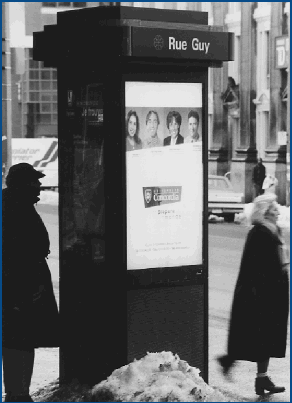
    |
 |
|
by Eugenia Xenos
 Chances are that you have seen the University's Image Campaign first-hand,
whether in the métro or bus, or on one of 54 advertising columns that dot the
city centre. The smiling Concordia graduates featured in the distinctive ads
bear witness that alumni go on to find satisfying work after receiving their
degrees here: "Real Education for the Real World," they say.
Chances are that you have seen the University's Image Campaign first-hand,
whether in the métro or bus, or on one of 54 advertising columns that dot the
city centre. The smiling Concordia graduates featured in the distinctive ads
bear witness that alumni go on to find satisfying work after receiving their
degrees here: "Real Education for the Real World," they say.
Now in its ninth year, the Campaign has, from the beginning, relied largely on transit advertising to establish a readily recognizable image and to gain greater visibility for the University -- mostly because of its effectiveness.
"We had to find an 'intrusive' medium that we could afford," said Jac Joanisse of Joanisse Marketing Communications, a group that has been advising the University on its marketing approach since the inception of the Image Campaign.
He said that TV, for example, is not that intrusive any more, due to a proliferation of stations and the remote control. Plus, it's expensive, especially on the English side. "And newspapers are not at all intrusive because they just sit on a table until you pick them up. But transit advertising are among those media that are 'in your face;' you can't avoid them. Of all the media we could afford, transit is the most effective."
The strategy has worked exceedingly well, drawing on a perception of Concordia as a provider of "practical education," and a 1989 survey in which 70 per cent of CEGEP students polled said they wanted to attend University either for specific career training, or to become more employable.
A study is being done this year to find out what potential graduate students look for when choosing a graduate school. The results should be known by the end of the school year.
Also this year, full colour and a fourth alumnus were added to the University's advertisements. In the past, three graduates were featured, but it was impossible to represent all four Faculties and the School of Graduate Studies with three.
Despite a relatively small budget, the Campaign has carved out a niche for Concordia and made it instantly recognizable. The transit ads run for 22 weeks a year in the greater Montreal area, and for 10 weeks in Quebec City, Sherbrooke, Toronto, Ottawa and Vancouver.
Last year, the University was able to supplement them with free advertising on the "OmniColumns" that are dispersed throughout the city. There's one right outside the Guy Métro station, a hop away from Concordia's main downtown buildings.
The OmniColumn part of the Campaign runs for four weeks this year, and the University is in the third year of a five-year agreement arranged by Board of Governors member Richard Renaud with Radio Mutuel's offshoot, la Société d'affichage Omni.
The Image Campaign has worked so well that other institutions have approached Concordia over the years to find out how it was done. Some think it's partly because of a consultative approach to the project. Decisions about the Campaign are now made by the Image Campaign Task Force, which is under the aegis of the Marketing and Institutional Communications Committee, chaired by Maria Paradiso, Executive Director of Communications. Representatives of the Faculties, Office of the Registrar, students, and Marketing Communications, among others, sit on the committee.



